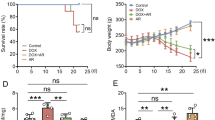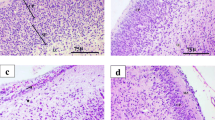Abstract
Cyclophosphamide (CYC) and doxorubicin (DOX) are among the most effective and widely used anticancer chemotherapeutic drugs. Potential chemopreventive and chemotherapeutic functions have recently been attributed to flavonoids. We hypothesized that Quercetin (QR) would protect against the toxic effects of chemotherapeutic agents applied prior to pregnancy. Rats were treated with the chemotherapeutic drugs CYC (27 mg/kg) and DOX (1.8 mg/kg) applied in a single intraperitoneal dose once every 3 weeks for 10 weeks. QR was administered at a dose of 10 mg/kg/day by oral gavage. 48 h following the experimental chemotherapy exposure, female rats were transferred to cages containing male rat for mating. Fetal brain tissues were removed from fetuses extracted by cesarean section on the 20th day of gestation for evaluation of antioxidant parameters. A significant increase in superoxide dismutase and malondialdehyde activity was observed in CYC and DOX treatment groups relative to the control group (p < 0.05). Similarly, carnitine acylcarnitine translocase and Glutathione activity was significantly reduced in the CYC and DOX groups relative to the control group (p < 0.05). Our results indicate that the use of chemotherapeutic drugs before pregnancy can result in oxidative damage to fetal brain tissue. Therefore, women who have been exposed to chemotherapy and may become pregnant should be treated with antioxidant compounds such as QR to reduce the risk of damage to fetal brain tissues.





Similar content being viewed by others
References
Aebi H, Catalase BH (1974) Methods of enzymatic analysis. Academic Press, New York and London, pp 673–677
Agarwal A, Saleh RA, Bedaiwy MA (2003) Role of reactive oxygen species in the pathophysiology of human reproduction. Fertil Steril 79:829–843
Bayne AV, Sohal RS (2002) Effects of superoxide dismutase/catalase mimetics on life span and oxidative stress resistance in the housefly, musca domestica. Free Radic Biol Med 32:1229–1234
Bines J, Oleske DM, Cobleigh MA (1996) Ovarian function in premenopausal women treated with adjuvant chemotherapy for breast cancer. J Clin Oncol 14:1718–1729
Black PH, Garbutt LD (2002) Stress, inflammation and cardiovascular disease. J Psychosom Res 52:1–23
Bolzan AD, Bianchi MS, Bianchi NO (1997) Superoxide dismutase, catalase and glutathione peroxidase activities in human blood: influence of sex age and cigarette smoking. Clin Biochem 30:449–454
Casado A, de La Torre R, Lopéz-Fernández E (2001) Antioxidant enzyme levels in red blood cells from cataract patients. Gerontol 47:186–188
Ceballos PI, Trivier JM, Nicole A, Sinet PM, Thevenin M (1992) Age- correlated modification of copper—zinc superoxide dismutase and glutationic related enzyme activities in human erythrocytes. Clin Chem 38(1):66–70
Cevik O, Cadırcı S, Sener TE, Tinay I, Akbal C, Tavuk HH, Cetinel S, Kıran D, Sener G (2013) Quercetin treatment against ischemia/reperfusion injury in rat corpus cavernosum tissue: a role on apoptosis and oxidative stress. Free Radic Res. 47:683–691. doi:10.3109/10715762.2013.814912
Cheng FC, Jen JF, Tsai TH (2002) Hydroxyl radical in living systems and its separation methods. J Chromatogr B Analyt Technol Biomed Life 781:481–496
Ciftci O, Vardi N, Ozdemir I (2013) Effects of quercetin and chrysin on 2,3,7,8-tetrachlorodibenzo-p-dioxin induced hepatotoxicity in rats. Environ Toxicol 28:146–154. doi:10.1002/tox.20707
Claeson K, Aberg F, Karlberg B (2000) Free malondialdehyde determination in rat brain tissue by capillary zone electrophoresis: evaluation of two protein removal procedures. J Chromatogr B Biomed Sci Appl 31:87–92
Delbes G, Vaisheva F, Luu T, Marcon L, Hales BF, Robaire B (2010) Reversibility of the effects of the chemotherapeutic regimen for non-Hodgkin lymphoma, cyclophosphamide, doxorubicin, vincristine, and prednisone, on the male rat reproductive system and progeny outcome. Reprod Toxicol 29:332–338. doi:10.1016/j.reprotox.2010.01.007
Doganay S, Borozan M, Iraz M, Ciqremis Y (2006) The effect of resveratrol in experimental cataract model formed by sodium selenite. Curr Eye Res 31:147–153. doi:10.1080/02713680500514685
Du G, Lin H, Yang Y, Zhang S, Wu X, Wang M, Ji L, Lu L, Yu L, Han G (2010) Dietary quercetin combining intratumoral doxorubicin injection synergistically induces rejection of established breast cancer in mice. Int Immunopharmacol 10:819–826. doi:10.1016/j.intimp.2010.04.018
Ellman GL (1959) Tissue sulfhydryl groups. Arch Biochem Biophys 82:70–77
Estany S, Palacio JR, Barnadas R, Sabes M, Iborra A, Mart´ınez P (2007) Antioxidant activity of N-acetylcysteine, flavonoids and α-tocopherol on endometrial cells in culture. J Reprod Immunol 75:1–10. doi:10.1016/j.jri.2007.01.007
Fadillioğlu E, Erdoğan H, Polat A, Emre H (2002) Renal antioxidant status in rats with hypertension ınduced by N sup omega nitro-l-arginine methyl ester. Kidney Blood Pres Res 25:211–216. doi:10.1159/000066341
Gilgun Y, Melaned E, Offen D (2001) Oxidative stress induced neurodegenerative diseases: the need for antioxidants that penetrate the blood brain barrier. Neuropharmacology 40:959–975
Gutteridge JM (1995) Lipid peroxidation and antioxidants as biomarkers of tissue damage. Clin Chem 41:1819–1828
Haliwel B, Gutterridge JM, Cross CE (1992) Free radicals antioxidants and human disease: where are we now? J Lab Clin Med 119:598–620
Howell SJ, Shalet SM (2002) Effect of cancer therapy on pituitary–testicular axis. Int J Androl 25:269–276. doi:10.1046/j.1365-2605.2002.00365
Howell SJ, Shalet SM (2005) Spermatogenesis after cancer treatment: damage and recovery. J Natl Cancer Inst Monogr 34:12–17. doi:10.1093/jncimonographs/lgi003
Ilhan N, Halifeoglu I, Ozercan HI, Ilhan N (2001) Tissue malondialdehyde andadenosine triphosphatase level after experimental liver ischaemia-reperfusion damage. Cell Biochem Funct 19:207–212. doi:10.1002/cbf.912
Jolitha AB, Subramanyam MV, Devi SA (2006) Modification by vitamin E and exercise of oxidative stress in regions of aging rat brain: studies on superoxide dismutase isoenzymes and protein oxidation status. Exp Gerontol 41:753–763
Lenton KJ, Therriault H, Fulop T, Payette H, Wagner JR (1999) Glutathione and ascorbate are negatively correlated with oxidative DNA damage in human lymphocytes. Carcinogenesis 20:607–613. doi:10.1093/carcin/20.4.607
Leyder M, Laubach M, Breugelmans M, Keymolen K, Greve JD, Foulon W (2011) Specific congenital malformations after exposure to cyclophosphamide, epirubicin and 5-fluorouracil during the first trimester of pregnancy. Gynecol Obstet Invest 71:141–144. doi:10.1159/000317264
Lowry O, Rosenbraugh N, Farr L, Rondell R (1951) Protein measurement with the folin-phenol reagent. J Biol Chem 183:265–275
Matouk AI, Taye A, Heeba GH, El-Moselhy MA (2013) Quercetin augments the protective effect of losartan against chronic doxorubicin cardiotoxicity in rats. Environ Toxicol Pharmacol 36:443–450. doi:10.1016/j.etap.2013.05.006
Meistrich ML (2009) Male gonadal toxicity. Pediatr Blood Cancer 53:261–266. doi:10.1002/pbc.22004
Mihara M, Uchiyama M (1978) Determination of malonaldehyde precursor in tissues by thiobarbituric acid test. Anal Biochem 86:271–278
Niestroy J, Barbara A, Herbst K, van Rode S, Liempt M, Roos PH (2011) Single and concerted effects of benzo [a] pyrene and flavonoids on the AhR and Nrf2-pathway in the human colon carcinoma cell line Caco-2. Toxicol InVitro 25:671–683. doi:10.1016/j.tiv.2011.01.008
Obeid M, Tesniere A, Ghiringhelli F, Fimia GM, Apetoh L, Perfettini JL (2013) Calreticulin exposure dictates the immunogenicity of cancer cell death. Nat Med 13:54–61. doi:10.1038/nm1523
Pryzant RM, Meistrich ML, Wilson E, Brown B, Mclaghlin P (1993) Long-term reduction in sperm count after chemotherapy with and without radiation therapy for non-Hodgkin’s lymphomas. J Clin Oncol 11:239–247
Ray G, Batra S, Shukla NK, Deo S, Raina V, Ashok S, Husain SA (2000) Lipid peroxidation, free radical production and antioxidant status in breast cancer. Breast Cancer Res Treat 59:163–170
Senturker S, Tschirret-GuthR MJ, Levine R, Shacter E (2002) Induction of apoptosis by chemotherapeutic drugs without generation of reactive oxygen species. Arch Biochem Biophys 397:262–272
Sestili P, Guidarelli A, Dacha M, Cantoni O (1998) Quercetin prevents DNA single strand breakage and cytotoxicity caused by tert-butylhydroperoxide: free radical scavenging versus iron chelating mechanism. Free Radic Biol Med 25:196–200
Shen J, Zhang W, Wu J, Zhu Y (2008) The synergistic reversal effect of multidrug resistance by quercetin and hyperthermia in doxorubicin-resistant human myelogenous leukemia cells. Int J Hyperthermia 24:151–159. doi:10.1080/02656730701843109
Singh A, Naidu PS, Kulkarni SK (2003) Reversal of aging and chronic ethanol-induced cognitive dysfunction by quercetin a bioflavonoid. Free Radic Res 37:1245–1252
Staedler D, Idrizi E, Kenzaoui BH, Juillerat-Jeanneret L (2011) Drug combinations with quercetin: doxorubicin plus quercetin in human breast cancer cells. Cancer Chemother Pharmacol 68:1161–1172. doi:10.1007/s00280-011-1596-x
Sun Y, Oberly LW, Li Y (1988) A simple method for clinical assay of SOD. Clin Chem 34:479–500
Tanir MH, Sener T, Inal M, Akyuz F, Uzuner K, Sivri E (2005) Effect of quercetin and glutathione on the level of superoxide dismutase, catalase, malonyldialdehyde, blood pressure and neonatal outcome in a rat model of pre-eclampsia induced by NG-nitro-l-arginine-methyl ester. Eur J of Obstet Gynecol Reprod Biol 118:190–195. doi:10.1016/j.ejogrb.2004.04.33
Taskin E, Dursun N (2014) Recovery of adriamycın induced mitochondrıal dysfunctıon in liver by selenium. Cytotechnology. doi:10.1007/S10616-014-9736-X
Taskin E, Ozdogan K, Kunduz Kindap E, Dursun N (2014) The restoration of kidney mitochondria function by inhibition of angiotensin-II production in rats with acute adriamycin-induced nephrotoxicity. Ren Fail 36:606–612
Vaisheva F, Delbes G, Hales BF, Robaire B (2007) Effects of the chemotherapeutic agents for non-hodgkin lymphoma, cyclophosphamide, doxorubicin, vincristine, and prednisone (CHOP), on the male rat reproductive system and progeny outcome. J Androl 28:578–587. doi:10.2164/jandrol.106.002428
Vanhees K, Schooten FJ, Khosrovani SB, Helden SV, Munnia A, Peluso M, Briede JJ, Haenen GR, Godschalk RW (2013) Intrauterine exposure to flavonoids modifies antioxidant status at adulthood and decreases oxidative stress-induced DNA damage. Free Radic Biol Med 57:154–161. doi:10.1016/j.freeradbiomed.2012.12.021
Walle T, Ta N, Kawamori T, Wen X, Tsuji PA, Walle UK (2007) Cancer chemopreventive properties of orally bioavailable flavonoids—methylated versus unmethylated flavones. Biochem Pharmacol 73:1288–1296. doi:10.1016/j.bcp.2006.12.028
Wessels AM, Flockhart DA, Carpenter JS, Radovich M, Li L, Miller KD, Sledge GW, Storniolo AM, Otte JL, Lemler SM, Schneider BP (2011) Cytochrome P450 polymorphisms and their relationship with premature ovarian failure in premenopausal women with breast cancer receiving doxorubicin and cyclophosphamide. Breast J 17:536–538. doi:10.1111/j.1524-4741.2011.01144.x
Acknowledgments
This research was supported by Inonu University Research Fund (INU-BAP 2010/58).
Author information
Authors and Affiliations
Corresponding author
Rights and permissions
About this article
Cite this article
Doğan, Z., Kocahan, S., Erdemli, E. et al. Effect of chemotherapy exposure prior to pregnancy on fetal brain tissue and the potential protective role of quercetin. Cytotechnology 67, 1031–1038 (2015). https://doi.org/10.1007/s10616-014-9742-z
Received:
Accepted:
Published:
Issue Date:
DOI: https://doi.org/10.1007/s10616-014-9742-z




